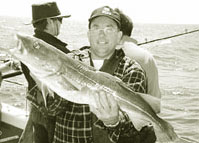

The European Union imposes strict restrictions on cod farming. But it could be too late



the European Union has slashed the North Sea cod quota by nearly half for 2001. Fisheries ministers who recently met in Brussels also agreed on a 10 per cent reduction in quotas for many other species. "These are the most drastic cuts we've had since quotas were introduced," said Franz Fischler, eu 's farm and fisheries commissioner . But restrictions may have come to late for the North Sea cod, feel experts. "Cod have been fished out and we're grinding along at rock bottom. Cutting the quota in itself won't achieve much," said John Shepherd of Southampton University. Meanwhile, representatives of the British fishing industry have warned that the cuts will devastate fishing communities.
But "cod is the real horror story", says Shepherd. Last year, fisherfolk managed to catch only 60 per cent of their quota. "That's very bad news. It means the fish are just not there to be found." Fisherfolk will be allowed to catch only 48,000 tonnes of cod next year, down from 80,000 tonnes.
"The problem is that it's very difficult to avoid catching cod if you're going to catch anything else. Cod are often caught unintentionally. If you set the quota too low, fisherfolk will have to throw dead cod back into the sea." Fishing for several fish species, such as haddock, involves unintentional cod catches. Earlier this month, the European Commission proposed cuts of 20 per cent in quotas for these species. But the ministers agreed a cut of only 10 per cent.
Shepherd thinks much tougher action will have to be taken if North Sea cod stocks are ever to recover. "I think the ec will have to try stopping fishing altogether in certain areas -- where there are large numbers of young cod, for example."
Meanwhile, a new study comes as another shock for the future of cod. Michael Lesser and his colleagues at the University of New Hampshire in Durham have found that in some areas increased ultraviolet ( uv) radiation resulting from the thinning of atmospheric ozone could be killing the cod larvae. Unless this stock loss is built into models "we might get ourselves into even more trouble", says Lesser.
The Atlantic cod spawn is in deep water, but the developing embryos float upwards to finish their development within 25 metres of the surface. At these depths they can be exposed to the increased levels of uv light. In laboratory experiments, Lesser found that 90 per cent of Atlantic cod larvae died within 10 days of being exposed to the level of uv light known to penetrate eight metres down in the Gulf of Maine. When the larvae were shielded with Plexiglas, which screens out uv , only one in three of them died ( Nature , Vol 404, p142).
We are a voice to you; you have been a support to us. Together we build journalism that is independent, credible and fearless. You can further help us by making a donation. This will mean a lot for our ability to bring you news, perspectives and analysis from the ground so that we can make change together.

Comments are moderated and will be published only after the site moderator’s approval. Please use a genuine email ID and provide your name. Selected comments may also be used in the ‘Letters’ section of the Down To Earth print edition.